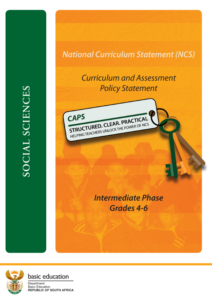Footprints/ Voetspore meets 80-90% of the CAPS Social Sciences requirements for the Intermediate (Grades 4-6) and Senior (Grades 7-9) Phases and exceeds them!
The first Footprints programme was created in 2002, long before the Curriculum Assessment Policy Statement, known by the acronym, CAPS, was published by the DBE in 2011.
We chose South African stories and used them as the history ‘core’ for our first literature-based programme. After that, we followed a similar process for the creation of our other programmes.
Footprints has never attempted to follow CAPS.
If you teach your children the three R’s and just read enough books to your children, and live an interesting life, working and playing, in relationship with one another, you can EASILY cover everything required by state education policies and more!
The proof of this can be seen in the success of our own adult children and the generation of home educated graduates, who followed a story-rich, eclectic approach to learning.
A Shocking Discovery
In December 2023, after updating our best-selling programme under the new name, Footprints – The Early Years (and Voetspore 1 – Die Vroeë in Afrikaans) we looked at CAPS and we were blown away by how similar the goals and content are. Below are some snippets from CAPS that we agree with wholeheartedly:
“This curriculum aims to ensure that children acquire and apply knowledge and skills in ways that are meaningful to their own lives. In this regard, the curriculum promotes knowledge in local contexts, while being sensitive to global imperatives.”
“…: encouraging an active and critical approach to learning, rather than rote and uncritical learning of given truths;”
“Valuing indigenous knowledge systems: acknowledging the rich history and heritage of this country as important contributors to nurturing the values contained in the Constitution…”
“The National Curriculum Statement Grades R-12 aims to produce learners that are able to:
- identify and solve problems and make decisions using critical and creative thinking;
- work effectively as individuals and with others as members of a team;
- organise and manage themselves and their activities responsibly and effectively;
- collect, analyse, organise and critically evaluate information;
- communicate effectively using visual, symbolic and/or language skills in various modes;
- use science and technology effectively and critically showing responsibility towards the environment and the health of others; and
- demonstrate an understanding of the world as a set of related systems by recognising that problem solving contexts do not exist in isolation.”
We are confident that home educating parents, who give their children individualised attention, will easily achieve these noble goals and others of their own, using any or all of our Footprints programmes.
On examination of the CAPS document, we were pleasantly surprised to see that Footprints, Voetspore (for History and Geography) and Footprints Nature Quest/Natuurskattejag (for Geography) are well-aligned with the topics prescribed by CAPS for Social Sciences. It was actually a shock to discover how many of the prescribed topics our programmes cover! And we did it first! We also have an article that explains how Footprints meets the CAPS requirement for Home Language in the Intermediate Phase: Footprints Language Arts and CAPS
As Footprints focuses primarily on a study of South Africa, the topics we don’t cover are mainly those that relate to the rest of the world.
Below is a chart that lists the topics on the CAPS document and shows which Footprints programme covers those topics.
Green shading = Footprints – The Early Years and Voetspore 1 – Die Vroeë Jare for ages 8-14
Yellow shading = Footprints – The Last Century and Voetspore 2 – Die Laaste Eeu for ages 10-16
Orange shading = Footprints Nature Quest/ Natuurskattejag for ages 8-16
Blue shading = More than one of our programmes covers the topic
Red shading = Topics not covered by a Footprints programme
Please also refer to the Footprints/Voetspore scope and sequence charts that follow. These show ALL THE OTHER topics that Footprints (Voetspore in Afrikaans) does cover, which EXCEED the requirements of CAPS. Footprints families will read over 20 chapter books per year, per programme, giving their children an enriching story-driven education (and academic advantage*) during the intermediate and senior phases (grades 4-9).
While the CAPS topics jump around randomly through time from year to year, Footprints and Voetspore offer students an in-depth, chronological study of the history of South Africa, which makes it easier to understand in the developing historical context. Our goal is to bring our country’s history to life, through stories, and give them a better understanding of why it is the way it is today.
The Footprints/Voetspore programmes focus on Social Studies, which includes history and geography, but being a multi-subject unit study, our programmes also cover language skills, poetry, South African music appreciation, SA art appreciation, art, crafts, cooking, technology and more!
CAPS History Content Topics Grades 4-6 – Intermediate Phase
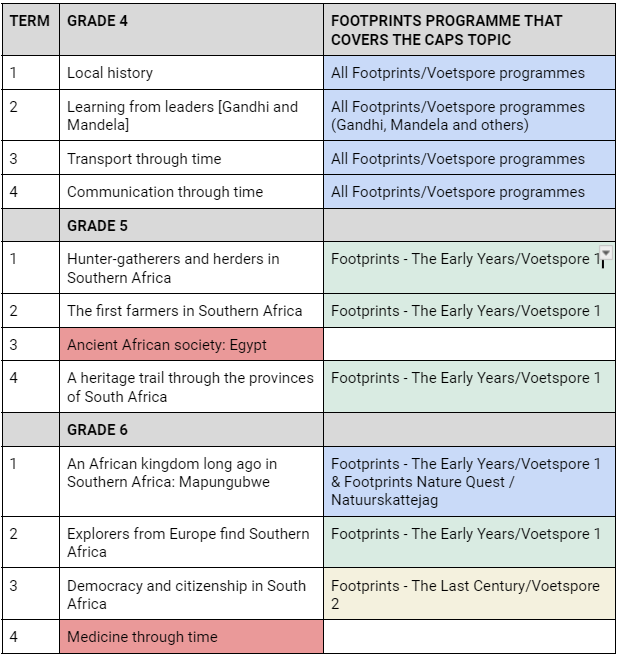
CAPS History Content Topics Grades 7-9 – Senior Phase
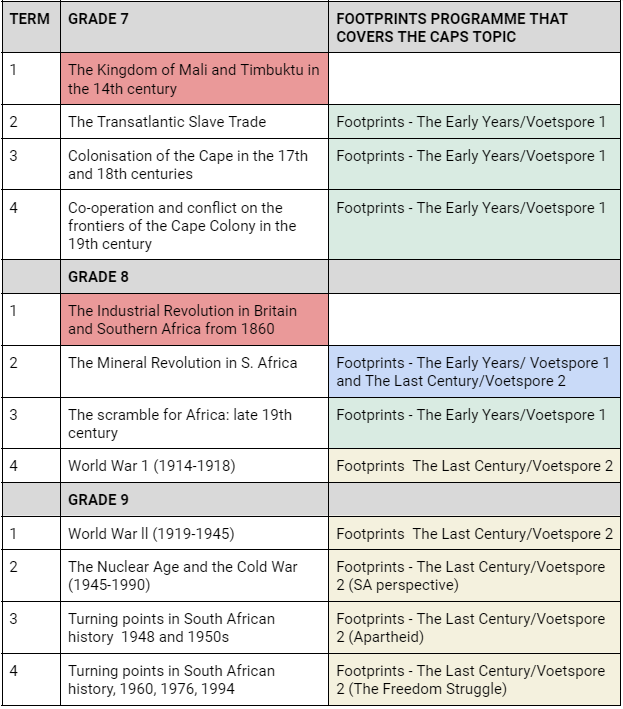
CAPS Geography Topics Grades 4-6 – Intermediate Phase
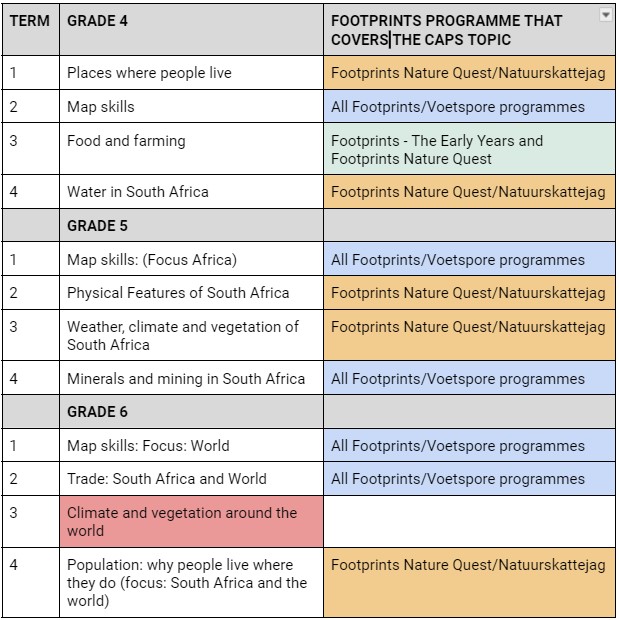
CAPS Geography Topics Grades 7-9 – Senior Phase
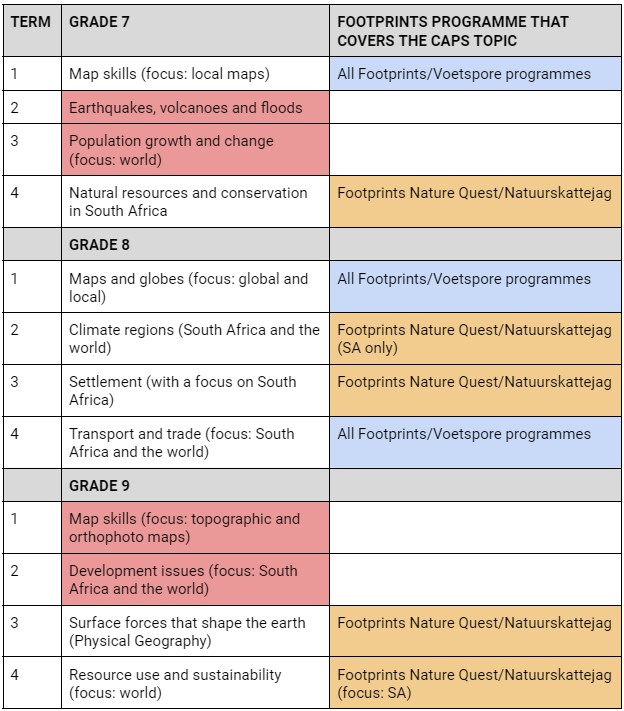
Footprints – Scope and Sequence
In comparison to children in schools, who study a textbook-based programme, families who use Footprints or Voetspore will study both reference material, giving the factual background information, as well about 20 stories. These historical novels place the factual information in a historical (or present-day) context, with captivating characters and plots that will engage the whole family’s attention.
*Research shows that reading books and parental involvement are two key factors that catapult academic success.
Researchers have discovered that the brains of children who are read to are more agile and receptive to narrative, suggesting that they have a greater capacity to process what they hear and at faster speeds than their non-read-to peers. In other words, reading aloud boosts brain function and academic performance.
Jessica Logan, lead author of a literacy study and assistant professor of educational studies at The Ohio State University, calls the discrepancy between children who are read to and those who aren’t “the million word gap”. Cumulatively, over the 5 years before preschool entry, researchers estimate that children from literacy-rich homes hear a cumulative 1.4 million more words during storybook reading than children who are never read to. This impacts their language abilities and other academic skills. Their non-read to peers never catch up!
We know that continuing reading through primary and high school develops a multitude of academic and critical thinking skills which are required for success as university students and as working adults.
The evidence has become so overwhelming that social scientists now consider reading aloud as one of the most important indicators of a child’s prospects in life!
…but that’s not all…
Reading aloud together improves family life. Where screens and technology lure us each into our own private virtual reality, reading aloud draws us together into a shared experience that connects us emotionally. There is ample research confirming that parental interest in a child’s education (whether at home or at school) has a positive and lasting effect on the child’s academic performance. If parents or caregivers value reading, children perceive it as important too.
Reading is a key that sets families free from the jail of hopelessness and apathy. Through stories, families learn that they are not alone in their struggles and that they can make a difference in their communities. They see how characters in stories and in history overcame similar challenges. We read about leaders who rose from obscurity to greatness and accomplished incredible feats for the benefit of their fellow men.
Stories also develop cultural insight and sensitivity and teach readers that there is always more than one narrative or perspective. It develops critical thinking skills! At Footprints, we don’t teach you WHAT to think, we encourage you to consider all sides of controversial issues and decide for yourself what you believe! While we believe that parents should teach their children their own moral values, we also challenge them to consider their potentially politically biased views and to learn about other perspectives.
Footprints – The Early Years / Voetspore 1
Scope and Sequence compared to CAPS
-
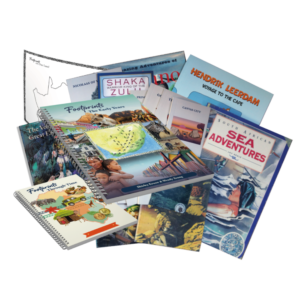 Footprints – The Early YearsR7 360.00
Footprints – The Early YearsR7 360.00
Every section listed below also includes a variety of other subjects and skills:
- Art Appreciation
- Poetry
- Music Appreciation
- Outings
- Art and crafts
- Mapwork
- Writing Assignments
- Narration
- Projects
| Footprints The Early Years/Voetspore 1 | List of topics | Correlation with CAPS Grade Level | CAPS Topics covered |
| Section 1 | |||
| First Inhabitants of South Africa | Introduction to the Early History of South Africa History is a Story The San of Africa The San Way of Life Sweet Treats Food and Social Roles San Beliefs Nama Languages The Khoena of Africa – Men of Men | Grade 5, Term 1 | Hunter-gatherers and herders in Southern Africa |
| Section 2 | |||
| Exploration of Africa | The Portuguese Navigators Prince Henry the Navigator Superstition Prejudice Bartolomeu Dias Vasco da Gama Padrãos Scurvy Navigation Instruments Caravels Dias’s Caravel Map History The Southernmost Point of Africa Charts and Trade Routes Shipwrecks on the South African Coast The Sao João (1552) The New Haerlem (1647) The Grosvenor (1782) The Arniston (1815) The Birkenhead (1852) The Kakapo (1900) The Waratah (1909) The Thomas T. Tucker (1942) The Antipolis (1977) Modern Water Transport | Grade 6, Term 2 Grade 4, Term 3 | Europeans explore South Africa Transport through time – Water Caravels Steamships Modern water transport |
| Section 3 | |||
| The Dutch at the Cape | The History of Banknotes in South Africa The Dutch Refreshment Station The Dutch East India Company Jan van Riebeeck Vryburghers Various Governors at the Cape (1652 – 1679) The Castle of Good Hope Simon van der Stel Interesting Facts about the Cape The Name Strandlopers The Tablecloth The Seal Trade Cape Dutch Houses Afrikaans – A Dutch Heritage The Dutch-Khoena Conflict Expansion and Land Seizure The Trekboer Problem | Grade 7, Terms 3 & 4 | Colonisation of the Cape in the 17th and 18th centuries Co-operation and conflict on the frontiers of the Cape Colony in the early 19th century |
| Section 4 | |||
| Slavery | Slavery in South Africa Slavery Worldwide The Transatlantic Slave Trade Slavery at the Cape Slave Treatment Slave Bells Slave Laws Slave Names Slave Surnames Free Blacks The Abolition of Slavery The Genetic Heritage of the Coloured Population Cape Malays The Moravian Mission Station The Cape Minstrel Carnival | Grade 7, Term 2 | The Transatlantic Slave Trade Heritage |
| Section 5 | |||
| The French Huguenots | Who were the Huguenots? Emigrants to the Cape The Sea Voyage to the Cape Influential Immigrants with Impact Simon van der Stel and the Huguenots The French at the Cape Willem Adriaan van der Stel Huguenot Heritage The Winelands The History of Winemaking in South Africa What Happened to the French in South Africa? | Grade 4, Term 1 Grade 5, Term 4 Grade 7, Term 3 | Transport Why People Live where they do Farming in SA Heritage Colonisation of the Cape in the 17th and 18th centuries |
| Section 6 | |||
| African Tribes | The Myth of the Empty Land (Mapungubwe and the Lydenburg Heads) Nguni Migration The Mfecane Black South Africans The Zulu Shaka Mzilikazi Dingaan Traditional Xhosa Clothing Xhosa Homes and Crafts Xhosa Beliefs isiXhosa Language | Grade 6, Term 4 | Why People Live in SA Heritage |
| Section 7 | |||
| British Rule | England and France (Napoleonic Wars) Changes at the Cape The Battle of Muizenberg The Battle of Blaauwberg The British Settlement of the Cape Colony The Frontier Wars Consequences of the Frontier Wars The 1820 Settlers’ Contribution to South Africa The Oldest Independent Newspaper in South Africa | Grade 7, Term 3 Grade 4, Term 4 | Colonisation of the Cape in the 17th and 18th centuries Communication through time |
| Section 8 | |||
| The Great Trek | Reasons for the Great Trek The Voortrekker Lifestyle The Beginnings of the Great Trek Advance Parties More Parties Join the Great Trek The Battle of Vegkop Trekker Parties Beyond the Orange River The Voortrekkers in Natal Second Visit to Dingaan and Betrayal Murders at Bloukrans The Battle of Italeni Andries Pretorius, the New Leader Who was Dingaan? The Battle of Blood River The Republic of Natal | Grade 7, Term 3 Grade 4, Term 3 | Colonisation of the Cape in the 17th and 18th centuries Transport through time – The Wagon |
| Section 9 | |||
| New Colonies | Natal Who was Dick King? The Barefoot Woman Transvaal Orange Free State Boer Republics and Griqua States Free State–Basotho Wars The Anglo-Zulu War of 1879 Indians in South Africa The Discovery of Mineral Wealth The Scramble for Africa | Grade 7, Term 3 Grade 8, Term 3 | Colonisation of the Cape in the 17th and 18th centuries The scramble for Africa Indian Heritage Why People live where they do |
Footprints – The Last Century / Voetspore 2 – Die Laaste Eeu
Scope and Sequence compared to CAPS
-
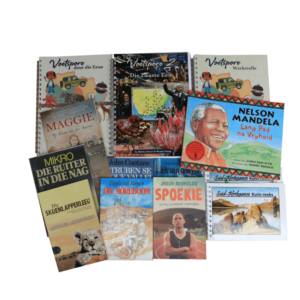 Voetspore 2 – Diamant PakketR6 655.00
Voetspore 2 – Diamant PakketR6 655.00
| Footprints The Early Years/Voetspore 1 | List of topics | Correlation with CAPS Grade Level | CAPS Topics covered |
| Section 1 | |||
| The Discovery of Mineral Wealth | Introduction to the Last 120 Years History is a Story The Discovery of Mineral Wealth The Discovery of Diamonds (1867) New Rush/Kimberley Mine Labour Who was Cecil John Rhodes? Rhodes Must Fall Movement The Story of Heartache The Discovery of Gold (1872) The Effects of the Discovery of Minerals The First Anglo-Boer War (1880-1881) Smallpox Epidemic of 1882 The Jameson Raid (1895) The Braamfontein Explosion (1896) The Witwatersrand How Diamonds are Formed Diamond in the Rough Characteristics of Diamonds Diamonds are Forever? Gold Alluvial Gold Hard Rock Mining Rock Types and the Rock Cycle Minerals Crystals Diamonds are Carbon Crystals | Grade 8, Term 2 Geography, Grade 5, Term 4 | The Mineral Revolution in SA Minerals and Mining in SA |
| Section 2 | |||
| The South African War | The Name of the War Black People’s Involvement in the War The Declaration of War (1899) Overview of the Second Anglo-Boer War Phase 1 – The Sieges Phase 2 – The Relief Black Week/Triumph Week Phase 3 – Guerilla Warfare and the Scorched Earth Policy Concentration Camps (1900-1902) Concentration Camp Cover-up Emily Hobhouse The Sparrow of Hope The Peace of Vereeniging (1902) The Union of South Africa (1910) The Mystery of the Kruger Millions | Grade 4, Term 2 Grade 10, Topic 6 | Learning from leaders The South African War and Union |
| Section 3 | |||
| Unification and World Wars | The Suffering Nation Unification of South Africa (1910) Native Land Act (1913) World War 1 in Brief (1914-1918) South Africa’s Part in World War 1 Great Depression of the 1930s What is Economics? The Effects of the Great Depression World War 2 in a Nutshell (1939-1945) What was the Treaty of Versailles? South Africa and World War 2 The Rise of Afrikaner Nationalism The Beginning of Apartheid (1948) | Grade 10, Topic 6 | The South African War and Union |
| Section 4 | |||
| Separation that Broke the Hearts of the Nation Apartheid Begins (1948) Racial Segregation Apartheid Homelands Resistance to Apartheid Indians in South Africa Who was Gandhi? Forced Removals Pass Laws The Defiance Campaign (1952) The Women’s March (1956) Sharpeville Massacre (1960) The Armed Struggle Nelson Mandela Jailed (1964) The Student Uprising (1976) | Grade 4, Term 2 Grade 9, Terms 3 & 4 | Learning from leaders Turning points in South African history 1948 and 1950s Turning points in South African history 1960, 1976 and 1994 | |
| Section 5 | |||
| The Border War & The Freedom Struggle | Compulsory Military Conscription South Africa’s Role in the Angolan Bush War Peace Negotiated “Terrorists” or “Freedom Fighters”? International Resistance to Apartheid The Afrikaner Weerstandsbeweging (AWB) and the Broederbond The Road to Democracy Mandela Released (1990) Robben Island The 1992 Referendum Pre-election Unrest The First Democratic Election (1994) | Grade 4, Term 2 Grade 9, Terms 3 & 4 Grade 12 | Learning from leaders Turning points in South African history 1948 and 1950s Turning points in South African history 1960, 1976 and 1994 Civil resistance 1970s-1980s: South Africa |
| Section 6 | |||
| Democracy | South Africa as a Democracy The New National Flag New Provinces Nelson Mandela’s Presidency (1994-1999) The Truth and Reconciliation Commission Thabo Mbeki’s Presidency (1999 – 2008) Motlanthe’s Presidency (2008-2009) Jacob Zuma’s Presidency (2009-2018) A Story from KwaZulu-Natal Cyril Ramaphosa’s Presidency (2018 – ) Riots in KZN and Gauteng Sport in the New South Africa The Role of Sport in Unifying South Africa The Springbok Sports Heroes – Inspirational Role Models or Dangerous Idolatry? Wayde van Niekerk | Grade 4, Term 2 Grade 9, Term 4 Grade 12, Topic 5 | Learning from leaders Turning points in South African history 1960, 1976 and 1994 The coming of democracy in South Africa and coming to terms with the past |
| Section 7 | |||
| Post-apartheid South Africa | Post-apartheid State Capture What is a “Kickback”? Who were the Guptas? Nepotism, Cadre Deployment and Affirmative Action The Farmgate Scandal The Muldergate Scandal Home Education – A Positive Impact on the Nation The History of Home Education in South Africa Home Education Beyond 2000 ‘Bad Weather’ Warning The Covid-19 Pandemic’s Effect on Home Education in South Africa Truth and a Free MediaMedia and Discernment Real Truth and Reconciliation in South Africa The Rhodes Must Fall Movement A National “Heart Transplant” | Not covered by CAPS |
Pick a Footprints Programme
-
 Footprints – The Early YearsR7 360.00
Footprints – The Early YearsR7 360.00 -
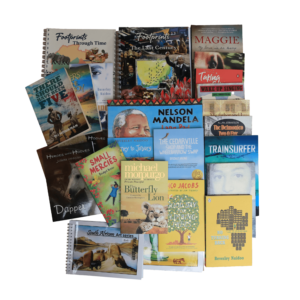 Footprints – The Last Century Diamond PackageR8 390.00
Footprints – The Last Century Diamond PackageR8 390.00 -
 Voetspore 2 – Diamant PakketR6 655.00
Voetspore 2 – Diamant PakketR6 655.00 -
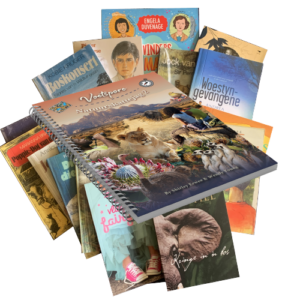 Natuurskattejag 2R5 365.00
Natuurskattejag 2R5 365.00 -
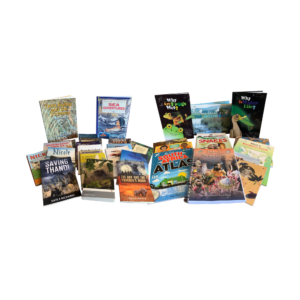 Footprints Nature Quest Classic PackR8 015.00
Footprints Nature Quest Classic PackR8 015.00
You may also find the following pages useful, if you need to create formal reports:
Homeschool Assessments, Reports and Compliance
Part 1 – Homeschool Assessments
Part 2 – Homeschool Reports
Part 3 – Should You Submit Homeschool Reports?

